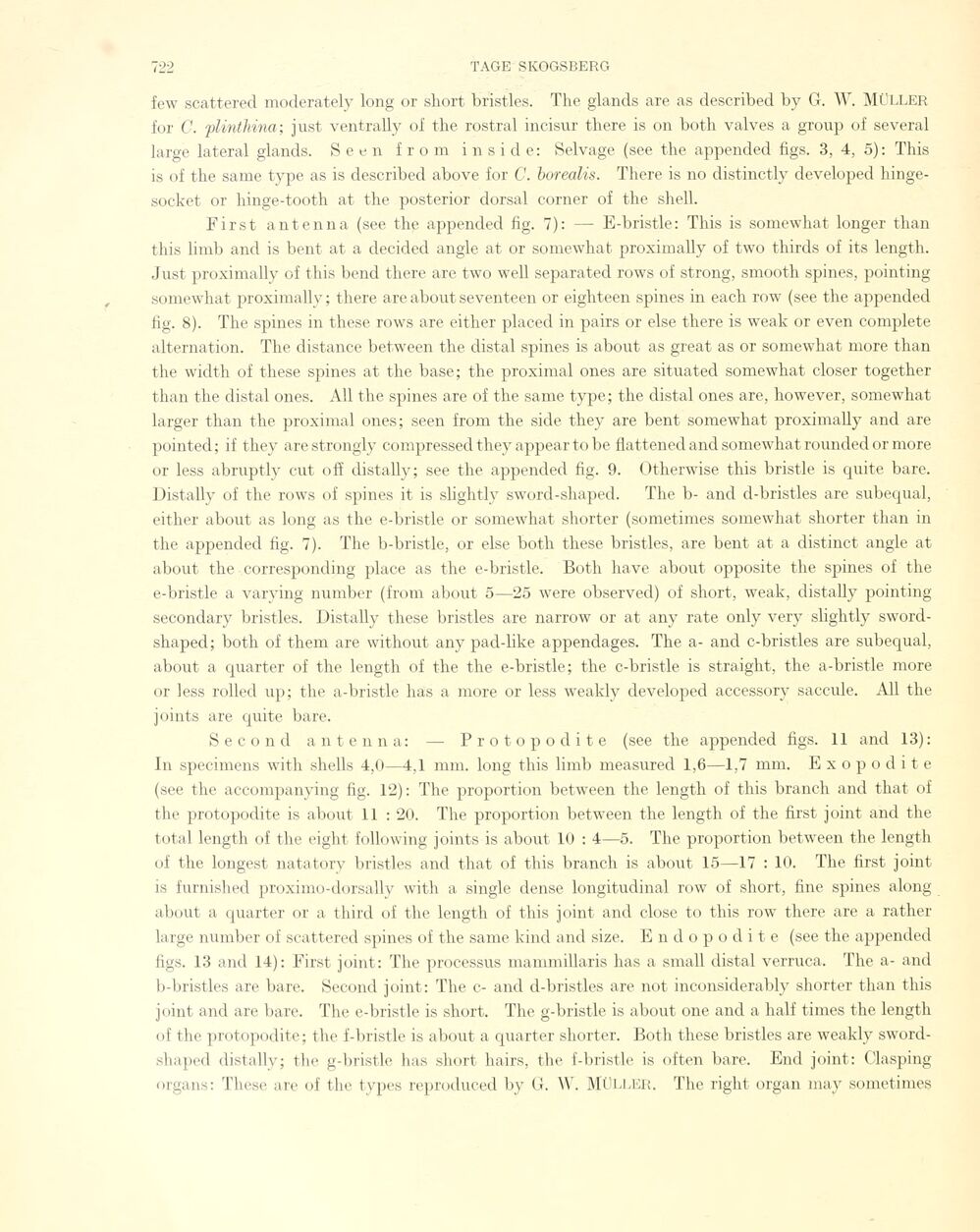
Full resolution (JPEG) - On this page / på denna sida - Sidor ...

<< prev. page << föreg. sida << >> nästa sida >> next page >>
Below is the raw OCR text
from the above scanned image.
Do you see an error? Proofread the page now!
Här nedan syns maskintolkade texten från faksimilbilden ovan.
Ser du något fel? Korrekturläs sidan nu!
This page has never been proofread. / Denna sida har aldrig korrekturlästs.
few scattered moderately long or short bristles. The glands are as described by G. W. MÜLLER
for C. plinthina; just ventrally ol the rostral incisur there is on both valves a group of several
large lateral glands. Seen from inside: Selvage (see the appended figs. 3, 4, 5): This
is of the same type as is described above for C. borealis. There is no distinctly developed
hinge-socket or hinge-tooth at the posterior dorsal corner of the shell.
First antenna (see the appended fig. 7): — E-bristle: This is somewhat longer than
this limb and is bent at a decided angle at or somewhat proximally of two thirds of its length.
Just proximally of this bend there are two well separated rows of strong, smooth spines, pointing
somewhat proximally; there are about se venteen or eighteen spines in each row (see the appended
fig. 8). The spines in these rows are either placed in pairs or else there is weak or even complete
alternation. The distance between the distal spines is about as great as or somewhat more than
the width of these spines at the base; the proximal ones are situated somewhat doser together
than the distal ones. Ail the spines are of the same type; the distal ones are, however, somewhat
larger than the proximal ones; seen from the side they are bent somewhat proximally and are
pointed; if they arestrongly compressed they appear tobe flattened and somewhat rounded or more
or less abruptly eut ofï distally; see the appended fig. 9. Otherwise this bristle is quite bare.
Distally of the rows of spines it is slightly sword-shaped. The b- and d-bristles are subequal,
either about, as long as the e-bristle or somewhat shorter (sometimes somewhat shorter than in
the appended fig. 7). The b-bristle, or else both these bristles, are bent at a distinct angle at
about the corresponding place as the e-bristle. Both have about opposite the spines of the
e-bristle a varying number (from about 5—25 wTere observed) of short, weak, distally pointing
secondary bristles. Distally these bristles are narrow or at any rate only very slightly
sword-shaped; both of them are without any pad-like appendages. The a- and c-bristles are subequal,
about a quarter of the length of the the e-bristle; the c-bristle is straight, the a-bristle more
or less rolied up; the a-bristle has a more or less weakly developed accessory saccule. All the
joints are quite bare.
Second antenna: — Protopodite (see the appended figs. 11 and 13):
In specimens with shells 4,0—4,1 mm. long this limb measured 1,6—1,7 mm. Exopodite
(see the accompanying fig. 12): The proportion between the length of this branch and that of
the protopodite is about 11 : 20. The proportion between the length of the first joint and the
total length of the eight following joints is about 10 : 4—5. The proportion between the length
of the longest natatory bristles and that of this branch is about 15—17 : 10. The first joint
is furnished proximo-dorsally with a single dense longitudinal row of short, fine spines along
about a quarter or a third of the length of this joint and close to this row there are a rather
large number of scattered spines of the same kind and size. Endopodite (see the appended
figs. 13 and 14): First joint: The processus mammillaris has a small distal verruca. The a- and
b-bristles are bare. Second joint: The c- and d-bristles are not inconsiderably shorter than this
joint and are bare. The e-bristle is short. The g-bristle is about one and a half times the length
of the protopodite; the f-bristle is about a quarter shorter. Both these bristles are weakly
sword-shaped distally; the g-bristle has short hairs, the f-bristle is often bare. End joint: Clasping
organs: These are of the types reproduced by G. W. MÜLLER. The right organ may sometimes
<< prev. page << föreg. sida << >> nästa sida >> next page >>